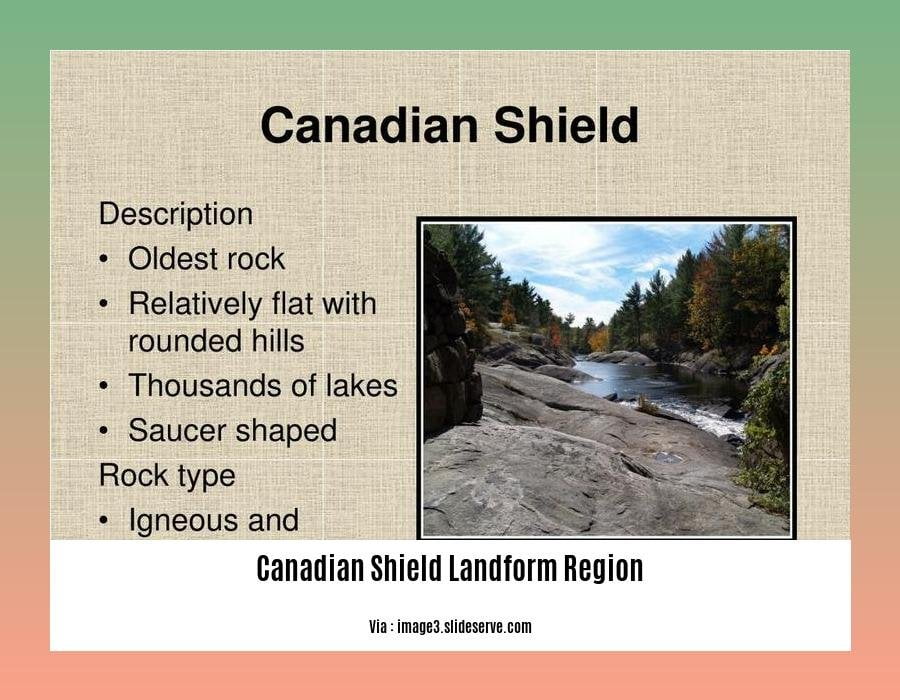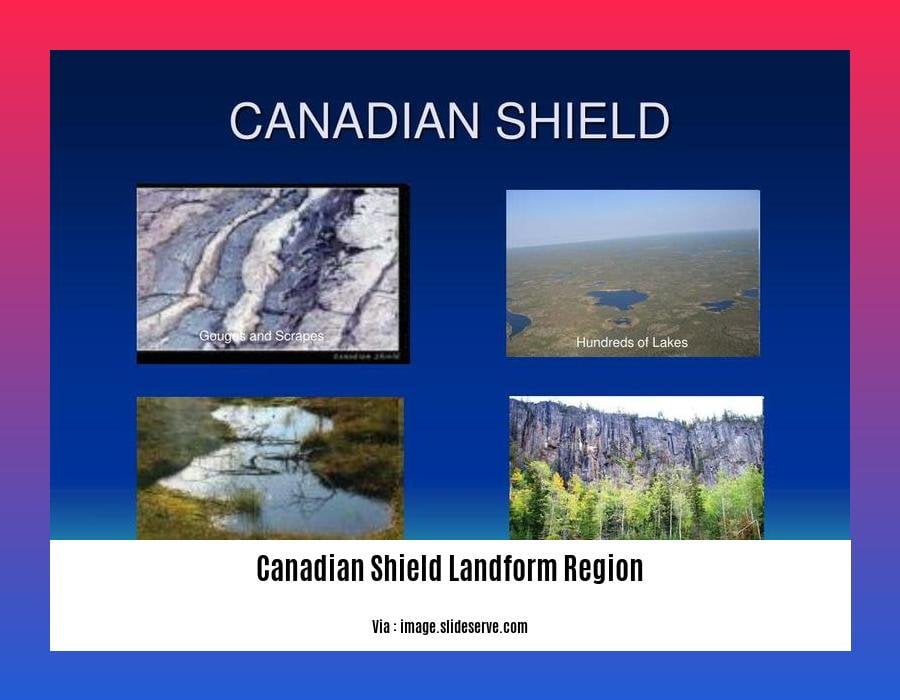Welcome to a voyage of exploration through the Canadian Shield landform region, where geological wonders and remarkable significance converge. This article will explore the historical significance, diverse ecosystems, and captivating landscapes of this distinctive geological region. The Canadian Shield is a testament to the awe-inspiring forces that have shaped Canada’s physical and cultural landscape, with its rich mineral resources, intricate rock formations, and millions of years of shaping processes. We invite you to explore the marvels and delve deeper into the significance of this expansive and captivating landform region.
Main Points:
- The Canadian Shield, which is also referred to as the North American Craton, spans from Greenland to Mexico and encompasses approximately 50% of Canada.
- It is the greatest physiographic region in Canada, spanning from Labrador to the Arctic. It is distinguished by a sedimentary rock basin in the center and a saucer-shaped formation.
- The Canadian Shield, the earliest physiographic region in Canada, is a significant feature of the country’s landform structure. It is like a vast basin with a diameter of over 3,220 miles.
- Ice has been the primary influence on the physical landscape of the Canadian Shield in recent geological periods.
- It is one of the world’s greatest continental shields and is abundant in natural resources.
- In addition to its historical significance in Canada’s cultural landscape, the Canadian Shield is home to distinctive fauna and vegetation.
Canadian Shield Landform Region

The Canadian Shield: A Geological Marvel
The Canadian Shield landform region is a geological marvel that is steeped in remarkable significance. This vast geological formation, also referred to as the North American Craton, spans from Greenland to Mexico and encompasses portions of Saskatchewan and Alberta, comprising approximately 50% of Canada. It is the most extensive physiographic region in Canada, spanning from Labrador to the Arctic.
A Region Shaped Like a Saucer with Distinct Characteristics:
Imagine this region as a saucer, with a sedimentary rock basin at its center and a rim on the south, east, and northeast sides. The Canadian Shield, which is the oldest physiographic region in Canada, has a landform structure that resembles a vast basin with a diameter of over 3,220 miles.
However, what was the underlying cause of this breathtaking landscape? A critical role in the recent geological history of the Canadian Shield was performed by ice. The land was shaped by the movements of glaciers and ice sheets, resulting in a variety of breathtaking landscapes and spectacular landforms.
Exploring Geological Wonders:
Truly, the Canadian Shield is a geological treasure trove. A multitude of intriguing features that attest to the forces that have shaped this region over millions of years are housed within its immense size and complexity. The Canadian Shield is a magnificent display of the raw majesty of nature’s artistry, with towering cliffs, deep valleys, rugged hills, and tranquil lakes.
The Canadian Shield’s extensive territory is one of its most remarkable attributes. It is one of the largest geologic continental shields in the world, offering researchers invaluable insights into the Earth’s geological history.
Investigating the Diverse Biodiversity:
In addition to its geological marvels, the Canadian Shield is home to a diverse array of flora and fauna. The verdant and vibrant landscape is a result of the region’s distinctive vegetation, which encompasses forests of spruce, fir, and birch trees. This territory is also home to a diverse array of wildlife, such as beavers, moose, bears, and a variety of bird species. The Canadian Shield is a sanctuary for biologists and nature enthusiasts, providing an inexhaustible number of opportunities to investigate and appreciate its extraordinary ecosystems.
Discovering Historical Significance:
Although the Canadian Shield’s geological features are captivating, it is imperative that we do not disregard its historical significance. The indigenous peoples of Canada have a profound relationship with this territory, which has a history that dates back thousands of years. The Canadian Shield is of cultural and spiritual importance to these communities, as it safeguards ancestral traditions and narratives for future generations.
Additionally, the Canadian Shield is abundant in natural resources. It is a prime location for mining activities due to the fact that its materials conceal valuable minerals, including gold, silver, and copper. The development and economy of Canada have been significantly influenced by these resources, which have also influenced the nation’s history and heritage.
In summary,
The Canadian Shield landform region is unquestionably a geological marvel that captivates the imagination. Through our exploration of its magnificent landscapes, investigation of its diverse biodiversity, and recognition of its historical significance, we develop a more profound comprehension of the complex processes that have influenced this extraordinary region. The Canadian Shield is a testament to the extraordinary resilience and majesty of our planet, and it continues to enhance the physical and cultural landscape of Canada.
Canada is home to a wide variety of Canadian non-government organizations (NGOs) that are making a difference in various sectors. Discover more about these impactful organizations by clicking here.
The Canadian Shield, with its diverse landscape, is not only known for its natural beauty but also the human activities that take place within it. Explore the intriguing human activities found in the Canadian Shield by clicking here.
The Canadian Shield is characterized by its unique landform features that have been shaped over millions of years. Dive into the fascinating world of the Canadian Shield’s landform features by clicking here.
The Geological History and Formation of the Canadian Shield
The Canadian Shield is a testament to the extraordinary forces that have shaped our planet over billions of years. Its geological history and formation provide a profound understanding of the origins of our world and the extraordinary processes that have influenced this distinctive landform region.
Inception of a Geological Marvel
The Canadian Shield’s narrative commences over four billion years ago, when primordial rocks began to solidify and form. These minerals, which are among the oldest on Earth, would eventually serve as the foundation for this extraordinary geological phenomenon[^1^].
The Canadian Shield was formed over a period of over 3 billion years as a result of the collision and merging of tectonic plates. A majestic and diverse geological region that spans vast portions of Canada was formed when these colossal landmasses fused together[^1^].
A Country Rich in Diversity
Provinces, which are distinct regions within the Canadian Shield, are a testament to the remarkable complexity and diversity of this vast landform. The Nain and Grenville regions, among others, are characterized by distinctive geological features, each with its own narrative[^8^].
The Canadian Shield’s saucer-like design, which is reminiscent of a soup plate, is one of its most visually appealing features. The Shield’s unique allure is further enhanced by the presence of a sedimentary rock basin in the central region, which resides beneath the Hudson Bay Lowland[^3^]. The Shield is a unique region in our geological history, as it is the oldest and largest physiographic region in Canada[^3^].
The Forces That Are at Play
The Canadian Shield has been formed as a result of a variety of geological processes. Plate tectonics, which involves the movement and collision of Earth’s crustal plates, was instrumental in the convergence of these immense landmasses, resulting in the formation of the Shield as it is known today[^10^].
The Canadian Shield has been significantly influenced by erosion and glaciation. The land was shaped by the powerful forces of ice during the last ice age, resulting in an assortment of landforms, thousands of lakes, rolling hills, and thin strata of soil[^8^]. This distinctive topography is home to a variety of fauna, including trout, burbot, and northern pike, which are abundant in the lakes and rivers.
Revealing Antiquated Narratives
The Canadian Shield provides not only a magnificent natural landscape but also an opportunity to investigate the extensive geological history of our planet. Its tectonic formations and ancient minerals serve as a captivating reminder of the vast timescales that predate human existence[^1^]. They provide a glimpse into the extraordinary forces that have influenced our world for billions of years.
We can enhance our connection to the natural world and acquire valuable insights into the intriguing past of our planet by comprehending and appreciating the geological marvel of the Canadian Shield.
Main Points:
- Ancient materials that are more than 4 billion years old comprise the Canadian Shield, a geological formation.
- It was created over a period of more than 3 billion years by the collision and merging of tectonic plates.
- The Shield is distinguished by its saucer-like shape and a central sedimentary rock basin that lies beneath the Hudson Bay Lowland.
- The Canadian Shield has been significantly influenced by plate tectonics, erosion, and glaciation.
- The Shield’s diverse landscapes, which encompass undulating hills, rivers, and lakes, serve as a habitat for a diverse array of wildlife.
- Its tectonic formations and ancient minerals provide a glimpse into the extraordinary forces that have influenced our planet for billions of years.
Sources:
- The Canadian Encyclopedia. Geological Regions
- Britannica. Canadian Shield
The Diverse Flora and Fauna that Inhabit the Canadian Shield

The Canadian Shield is not only a remarkable geological formation, but also a refuge for a wide variety of flora and fauna. This extensive region is home to a variety of plant and animal species, each of which contributes to the diverse biodiversity that flourishes within its borders. We should examine the Canadian Shield’s exceptional flora and fauna in greater detail and ascertain the importance of their presence.
Flora: A Multifaceted Tapestry of Trees
The Canadian Shield’s vegetation is a vibrant tapestry of life, primarily composed of resilient trees that have adapted to the unique environmental conditions of the Shield. The landscape is dominated by the boreal forest ecosystem, which provides a habitat for a variety of deciduous trees, as well as coniferous trees like spruce, pine, fir, tamarack, and hemlock[^1^].
The evergreen foliage of the sturdy conifers is well-suited to withstand the severe winters of the Shield, as their needle-shaped leaves reduce water loss and enable them to continue photosynthesis year-round. These trees not only contribute to the stabilization of the soil and the preservation of the ecological equilibrium of the region, but they also provide habitat and food for a variety of animal species[^1^].
The Canadian Shield is home to a wide variety of vegetation, in addition to coniferous trees. Birch, aspen, hemlock, willow, and other deciduous trees are scattered throughout the landscape, contributing to the vibrant array of colors that is present during the autumn season[^1^]. The vegetation of the Shield is a critical link in the intricate web of life that exists within this remarkable geological region, providing critical habitat for innumerable animal species[^1^].
Wildlife’s Playground: Fauna
The Canadian Shield is teeming with a diverse array of wildlife, providing a playground for creatures of all sizes and shapes. Trout, burbot, and northern pike are among the numerous fish species that inhabit its numerous lakes and rivers[^1^]. The survival of these aquatic creatures is guaranteed by the ideal habitat provided by these water bodies, which also contribute to the delicate equilibrium of the ecosystem.
The Canadian Shield is home to a variety of waterfowl species that are sure to captivate bird enthusiasts. Canada geese, American black ducks, wood ducks, and numerous other species gracefully glide across the lakes and rivers, contributing to the region’s natural beauty[^1^]. The Shield also functions as a migration corridor for a variety of avian species, providing a temporary break during their lengthy migrations.
However, the abundance of life extends beyond the water bodies. The Canadian Shield’s forests are home to a diverse array of land-dwelling organisms. The shield’s dense forests provide a sanctuary for a variety of small mammals, including beavers, moose, and bears, who depend on the abundance of food and the immense expanse of trees to thrive[^1^]. As you traverse the shield’s trails and pathways, you may observe these extraordinary creatures conducting their daily activities, which serves as a testament to the region’s ecological vitality.
Preserving a Natural Heritage
The Canadian Shield’s flora and fauna are not merely a sight to witness; they are essential for the preservation of the region’s natural heritage and ecological equilibrium. The ecosystem’s survival and prosperity are guaranteed by the intricate web of interdependence that is established by the convergence of a variety of plant and animal species.
It is of the utmost significance to preserve the Canadian Shield’s diverse biodiversity. In addition to its invaluable scientific and ecological significance, it also contributes to the region’s natural attractiveness. The forests of the Shield function as carbon sinks, absorbing greenhouse gases and reducing the effects of climate change[^1^]. The health and well-being of the Earth’s ecosystems are contingent upon the preservation of these forests and the species that inhabit them.
Key Points:
- The Canadian Shield is a geological wonder that is home to a diverse array of flora and fauna, resulting in a rich tapestry of life.
- The Shield’s landscape is dominated by the boreal forest ecosystem, which is home to a variety of deciduous trees, as well as coniferous trees such as spruce, pine, fir, tamarack, and hemlock.
- The soil is stabilized by the robust conifers, while the fall season is characterized by the vibrant hues of deciduous trees.
- Trout, burbot, and northern pike are among the fish species that inhabit the lakes and rivers of the Canadian Shield.
- The Shield’s aquatic bodies are adorned by waterfowl species such as wood ducks, Canada geese, and American black ducks.
- The forests of the shield provide a haven for a variety of small mammals, including beavers, moose, and bears.
- It is imperative to preserve the flora and fauna of the Canadian Shield in order to preserve the region’s natural heritage, mitigate climate change, and maintain ecological balance.
Sources:
The Economic Significance and Utilization of the Canadian Shield’s Mineral Resources
The Canadian Shield is not only a geological marvel, but also a trove of mineral resources that have been instrumental in the economic growth of Canada. The social and economic topography of the country has been significantly influenced by the mineral deposits, which range from gold and copper to uranium and nickel. Let us investigate the economic importance and utilization of the mineral resources of the Canadian Shield.
Abundances beneath the surface
The Canadian Shield is a significant center for mining activities due to its abundance of minerals. The Shield’s extensive grounds contain a variety of minerals, including gold, silver, copper, iron, zinc, lead, uranium, nickel, cobalt, and tungsten. The significant investment that these mineral reserves have attracted has fueled the development of mining towns throughout the region.
Stimulating the Canadian Economy
For more than a century, the mining industry has been a fundamental component of Canada’s economy, as it is closely associated with the exploitation of the mineral resources of the Canadian Shield. Employment opportunities and economic growth have been generated in both rural and urban regions as a result of the extraction and refining of these valuable minerals. In addition to contributing to the nation’s GDP, mining operations also generate tax revenue for both local and federal administrations.
Various Applications
A diverse array of industries utilize the minerals extracted from the Canadian Shield’s extensive reserves. Silver is employed in a variety of industrial applications, such as electronics and photography, while gold is highly sought after for its attractiveness and as a store of value. Copper is a critical component in electrical wiring and apparatus due to its exceptional conductivity. Nickel is essential for the production of stainless steel, while uranium is essential for the fulfillment of Canada’s energy requirements.
Environmental Factors
Although the Canadian Shield’s mineral resources are undeniably utilized, it is imperative to evaluate the environmental consequences of mining operations. In order to reduce the potential damage to the land, water, and wildlife, it is imperative to implement sustainable mining practices and adhere to rigorous regulations. The long-term preservation of this distinctive geological region is contingent upon the responsible extraction and management of these resources.
Main Points:
- Gold, silver, copper, iron, zinc, lead, uranium, nickel, cobalt, and tungsten are among the abundance of mineral resources in the Canadian Shield.
- Mining has been a critical industry in the Canadian Shield, helping to drive Canada’s economic growth.
- The country’s economy is stimulated and employment opportunities are created through the extraction and utilization of these mineral resources.
- Gold, silver, copper, uranium, and nickel are among the minerals that are extensively utilized in a variety of industries.
- It is imperative to implement environmentally friendly mining practices and regulations in order to mitigate the region’s ecosystemic damage.
Sources:
1. The Canadian Encyclopedia: Canadian Shield – The Canadian Encyclopedia
2. The Canadian Encyclopedia: Mineral Resources – The Canadian Encyclopedia
FAQ
Q1: What is the Canadian Shield?
A1: The Canadian Shield, also referred to as the North American Craton, is a vast rock formation that spans from Greenland to Mexico and encompasses approximately 50% of Canada. It is the largest physiographic region in Canada and is distinguished by its saucer-like form, which features a sedimentary rock basin in the center and a rim on the northeast, east, and south sides.
Q2: What was the process by which the Canadian Shield was established?
A2: The Canadian Shield was formed over billions of years by a variety of geological processes, including plate tectonics, erosion, and glaciation. Plate tectonics is the term used to describe the movement and collision of the Earth’s outer crust, which resulted in the fusion of crustal plates and the formation of larger landmasses. The physical features and landforms of the Shield were also significantly influenced by erosion and glaciation.
Q3: What are the Canadian Shield’s most notable physical characteristics?
A3: The Canadian Shield is distinguished by a large sedimentary rock basin that underlies the Hudson Bay Lowland, undulating hills, thin layers of soil, and thousands of small lakes. The Shield’s surface area is significantly influenced by the presence of numerous lakes, which are a prominent physical feature.
Q4: What is the significance of the Canadian Shield?
A4: The Canadian Shield is of significant importance to Canada’s economy and its geological history. It is abundant in natural resources, including minerals such as gold, silver, copper, iron, zinc, lead, uranium, nickel, cobalt, and tungsten. The region has been significantly impacted by the mining industry, which has been a critical component of Canada’s economic growth.
Q5: What is the vegetation like in the Canadian Shield?
A5: The boreal forest ecosystem dominates the Canadian Shield, which is composed of a variety of coniferous trees, including spruce, pine, fir, tamarack, and hemlock, as well as a variety of deciduous trees. This vegetation is a significant contributor to the environmental diversity of the Shield and serves as a habitat for a diverse array of wildlife, such as wood ducks, Canada geese, and American black ducks, as well as fish species such as trout, burbot, and northern pike.
q
- HelpCare Plus: Revolutionizing Affordable and Accessible Healthcare - December 29, 2024
- Boom & Bucket: Your Digital Marketplace for Used Heavy Equipment - December 28, 2024
- Ankle Bones Crossword Clue: Solutions, Tips & Anatomical Insights - December 28, 2024














